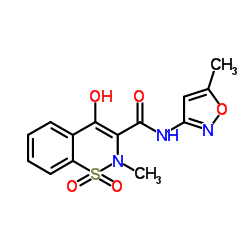In vivo metabolism of isoxicam in rats, dogs, and monkeys.
T F Woolf, A Black, J L Hicks, H Lee, C C Huang, T Chang
文献索引:Drug Metab. Dispos. 17(6) , 662-8, (1989)
全文:HTML全文
摘要
Isoxicam is a long half-life nonsteroidal anti-inflammatory agent which undergoes extensive metabolism prior to elimination in animals and man. The major route of isoxicam transformation is hydroxylation of the methylisoxazole functionality to form hydroxymethylisoxicam, and cleavage of its benzothiazine moiety to give an oxoacetic acid metabolite. The metabolic pathway for scission of the benzothiazine moiety to the oxoacetic acid metabolite and to other potential metabolites is not known. To gain additional information on the metabolic fate of isoxicam, 14C-isoxicam labeled on the N-methyl group was administered to rats, dogs, and monkeys with urine and feces collected for metabolic profiling and identification. Identified as new metabolites of isoxicam were an open-ring sulfonamide, N-methylsaccharin, and saccharin. The formation of these metabolites suggests that isoxicam undergoes direct oxidative scission of its benzothiazine ring at carbon atom 3 to generate the observed open-ring sulfonamide, N-methylsaccharin, and oxoacetic acid metabolites.
相关化合物
| 结构式 | 名称/CAS号 | 分子式 | 全部文献 |
|---|---|---|---|
 |
伊索昔康
CAS:34552-84-6 |
C14H13N3O5S |
|
Effect of some new prostaglandin synthetase inhibitors on th...
1988-04-01 [Res. Commun. Chem. Pathol. Pharmacol. 60(1) , 19-25, (1988)] |
|
[The effect of estro-progesterones on the inflammatory episo...
1989-10-01 [Rev. Rhum. Mal. Osteoartic. 56(10) , 709-11, (1989)] |
|
Controlled-release naproxen compared with isoxicam in patien...
1988-01-01 [Curr. Med. Res. Opin. 11(1) , 28-33, (1988)] |
|
Liquid chromatography-tandem mass spectrometry method for th...
2009-04-01 [Bioanalysis 1(1) , 63-70, (2009)] |
|
In vitro metabolism of isoxicam by horseradish peroxidase.
1989-12-01 [Xenobiotica 19(12) , 1369-77, (1989)] |